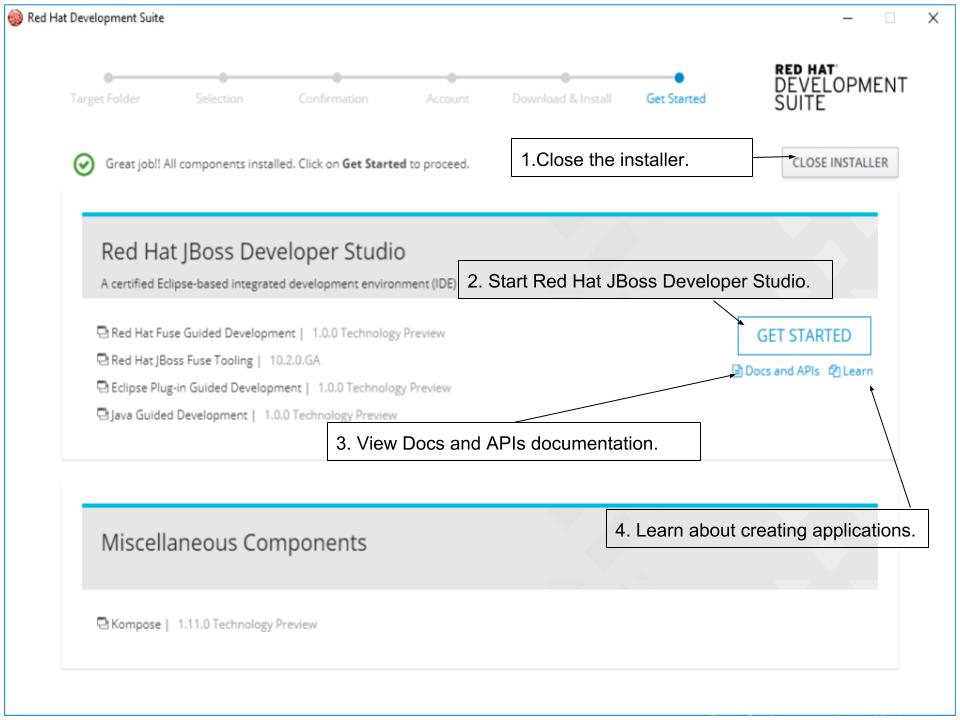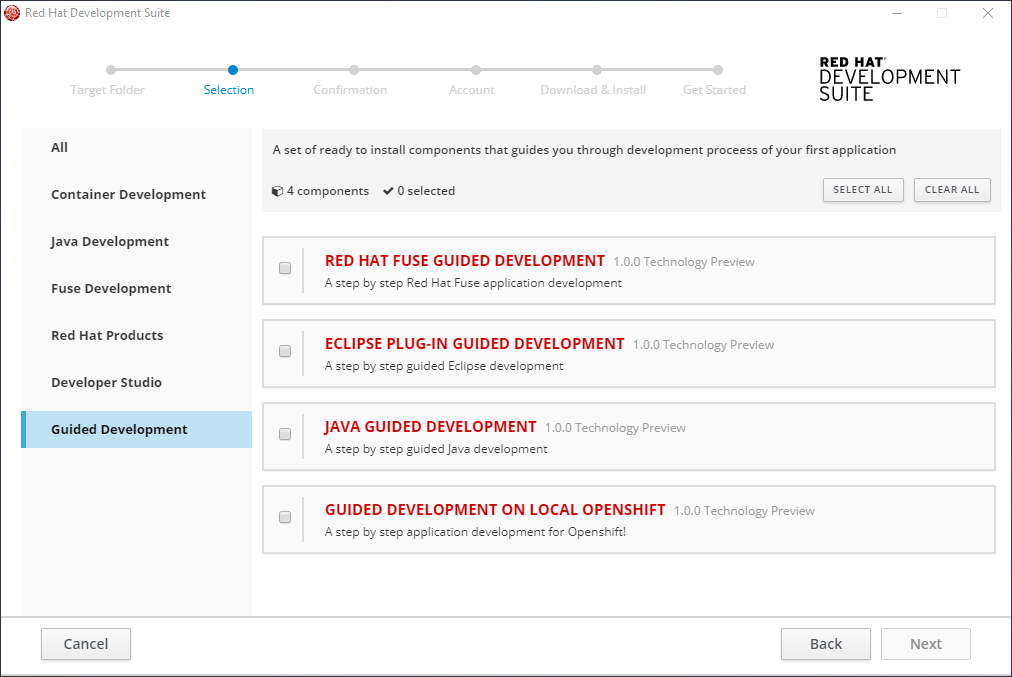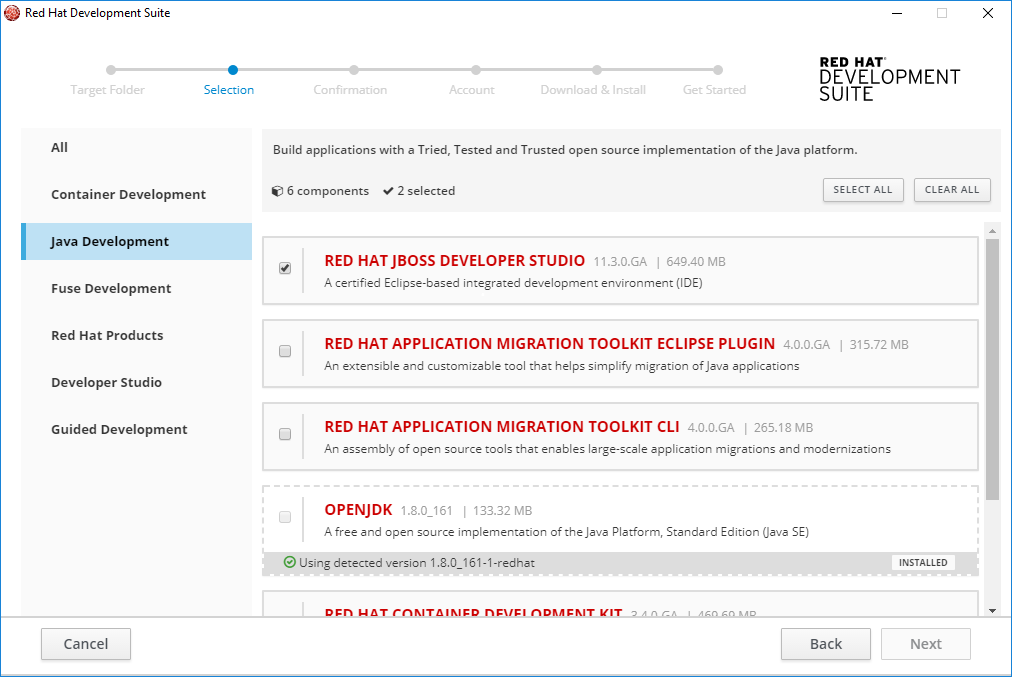-
Language:
English
-
Language:
English
Red Hat Training
A Red Hat training course is available for Red Hat Development Suite
Release Notes and Known Issues
Highlighted features in Red Hat Development Suite 2.3
Petra Sargent
psargent@redhat.comdevtools-docs@redhat.com
Abstract
Chapter 1. About Red Hat Development Suite 2.3
Red Hat Development Suite 2.3 bundles several Red Hat and non-Red Hat products together, such as:
- Red Hat JBoss Developer Studio 11.3.0
- Red Hat Container Development Kit 3.4.0
- Third-party tools, such as Kompose
- Dependencies for some of these products
Red Hat Development Suite is supported on the following platforms:
- Windows 7, 8, and 10
- macOS 10.9 or newer
- Red Hat Enterprise Linux 7
A user who wants to download and use Red Hat Development Suite must become a member of the Red Hat Developer Program. Sign up for the program here: Red Hat Developer Program.
1.1. Red Hat Development Suite Installation options
1.1.1. Red Hat Development Suite as an Online Installer
You can download Red Hat Development Suite as an online installer for Windows and macOS. The online installer downloads the required components during the installation process and is approximately 60 MB.
1.1.2. Red Hat Development Suite as a Bundled Installer
You can download Red Hat Development Suite as a bundled installer for Windows and macOS that has an initial download of approximately 1 GB and includes the following tools:
- Red Hat Container Development Kit
- Red Hat JBoss Developer Studio
- OpenJDK
- Cygwin
1.1.3. Red Hat Development Suite with the Standard Package Management System
Red Hat Enterprise Linux uses RPM packages to install Red Hat Container Development Kit, Red Hat JBoss Developer Studio, Red Hat JBoss Enterprise Application Platform, and Kompose.
Chapter 2. What Is New in Red Hat Development Suite 2.3?
2.1. Technology Preview
Guided Development is included as a Technology Preview feature in Red Hat Development Suite.
For more information on Guided Development, see Section 2.7, “Guided Development Feature”.
For more information on Red Hat Technology Preview features support scope, see Technology Preview Features Support Scope.
2.2. New Components
Red Hat Development Suite 2.3 includes the following new components on Windows and macOS:
- Red Hat Fuse Guided Development 1.0.0 (Technology Preview)
- Eclipse Plug-in Guided Development 1.0.0 (Technology Preview)
- Java Guided Development 1.0.0 (Technology Preview)
- Guided Development On Local Openshift 1.0.0 (Technology Preview)
- Red Hat Application Migration Toolkit CLI 4.0.0
2.3. Updated Component Versions
Red Hat Development Suite 2.3 has the following version updates:
- Red Hat JBoss Developer Studio Central Repository 11.3.0
- Red Hat JBoss Developer Studio 11.3.0
- Red Hat Container Development Kit 3.4.0
- Red Hat JBoss Fuse Tooling 10.3.0
- Kompose 1.11.0 (Technology Preview)
- Oracle Virtualbox 5.2.8
- Cygwin 2.10.0
- OpenJDK 8u161
Table 2.1 Components Details shows a list of components that are updated this release and their supported platforms. See Red Hat Development Suite Installation Guide for a full list of components.
Table 2.1. Component Details
| Updated Components | Windows | macOS | Red Hat Enterprise Linux |
|---|---|---|---|
| Red Hat JBoss Developer Studio Central Repository 11.3.0 | ✔ | ✔ | ✖ |
| Red Hat JBoss Developer Studio 11.3.0 | ✔ | ✔ | ✔ |
| Red Hat Container Development Kit 3.4.0 | ✔ | ✔ | ✔ |
| Red Hat JBoss Fuse Tooling 10.3.0 | ✔ | ✔ | ✖ |
| Kompose 1.11.0 (Technology Preview) | ✔ | ✔ | ✔ |
| Oracle Virtualbox 5.2.8 | ✔ | ✔ | ✔ |
| Cygwin 2.10.0 | ✔ | ✔ | ✖ |
| OpenJDK 8u161 | ✔ | ✔ | ✖ |
2.4. Xhyve Hypervisor Now Supported for macOS
Red Hat Development Suite now automatically selects Xhyve as the hypervisor for macOS.
Figure 2.1. Xhyve is detected

When Xhyve is not detected, you can either enable Xhyve or use Oracle VirtualBox. Red Hat Development Suite now provides a link to step-by-step instructions.
Figure 2.2. Xhyve is not detected

After you enable Xhyve on the installer window, Red Hat Development Suite window now has xhyve as hypervisor.
2.5. macOS Installer Now Available as Disk Image file
Red Hat Development Suite is now available as a disk image file (.dmg) for macOS. You can now either:
Run Red Hat Development Suite directly from mounted disk image.
or
- Click and drag the disk image file to the Application folder.
2.6. Installed Components Detection Performance Improvements
The time it takes Red Hat Development Suite to detect an installed component is reduced from five seconds to almost instant detection.
2.7. Guided Development Feature
Guided Development lets you install a set of developer tools and view step-by-step instructions on how to create, build and deploy an application. The instructions are called cheat sheets. You view them in JBoss Developer Studio. The toolsets are grouped by guided development components.
Table 2.2. Guided Development Components, toolsets and cheat sheets
| Guided Development Components | Toolsets | Cheat Sheets (step-by-step instructions) |
|---|---|---|
| Java Guided Development | OpenJDK 8u161 Red Hat JBoss Developer Studio 11.3.0 | Create a Hello World Java Application Create a Hello World SWT Java application |
| Red Hat Fuse Guided Development | Red Hat JBoss Fuse Tooling 10.3.0 OpenJDK 8u161 Red Hat JBoss Developer Studio 11.3.0 Red Hat JBoss Fuse on Apache Karaf 6.3 | Create a Fuse Integration Project |
| Eclipse Plug-in Guided Development | OpenJDK 8u161 Red Hat JBoss Developer Studio 11.3.0 | Creating an Eclipse plug-in Create Eclipse rich client application |
| Guided Development on local OpenShift | Cygwin 2.10.0 OpenJDK 8u161 Red Hat Container Development Kit 3.4.0 Red Hat JBoss Developer Studio 11.3.0 | Creating, building and deploying an application to OpenShift |
2.8. Enhanced User Interface
Red Hat Development Suite 2.3 includes several new user interface changes. See Red Hat Development Suite 2.3 Installation Guide for detailed installation instructions.
2.8.1. Changes to the Get Started Window
You can now view components that are installed successfully, start JBoss Developer Studio or view documentation from the Get Started window. The installed components are now displayed by the following groups:
- Red Hat JBoss Developer Studio and dependents
- Red Hat Container Development Kit and dependents
- Miscellaneous Installed Components
Figure 2.3 shows what you can do from the Getting Started window:
- 1.Close the installer.
- 2.Start Red Hat JBoss Developer Studio.
- 3.View Docs and APIs documentaton.
- 4.Learn about creating applications.
Figure 2.3. Getting Started

2.8.2. Guided Development Channel Now Added to the Selection Window
You can select the Guided Development channel on the Selection window. The new components in the Guided Development channel are:
- Red Hat Fuse Guided Development
- Eclipse Plug-in Guided Development
- Java Guided Development
- Guided Development on Local OpenShift
Figure 2.4. Guided Development

2.8.3. Red Hat Application Migration Toolkit CLI Now Added to List of Components
You can select Red Hat Application Migration Toolkit CLI as a component in the Java Development Channel.
Figure 2.5. Red Hat Application Migration Toolkit CLI

Chapter 3. Known Issues
Red Hat Development Suite issues are now tracked in GitHub.
3.1. Fixed Issues
- JBDS-4485 - Deselected components get selected during second detection run
- http://github.com/redhat-developer-tooling/developer-platform-install/issues/1158 - MacOS install should use dmg
- http://github.com/redhat-developer-tooling/developer-platform-install/issues/1094 - Loss of window focus causes duplicate check for installed components
3.2. Known Issues
Red Hat Development Suite 2.3 has the following known issues:
- #1151 - DevSuite Installer hung during install waiting for cygwin
- #1052 - DevSuite Installer should work behind proxy
- #1110 - Request for Administrator credentials should be shown once
- #1129 - DevStudio installation fails when (Windows) user has non-ascii chars in the name
- #1128 - Installer should update detected Virtualbox
- #1029 - Provide a .exe for uninstaller on Windows
- #1109 - Detect pending reboot and ask to reboot before continue with installation
- #1171 - Installer does not support SOCKS proxy
Chapter 4. Next Steps
Try the Red Hat Development Suite installer using the following instructions: Red Hat Development Suite 2.3 Installation Guide.
If you have already installed Red Hat Development Suite, start using it with these instructions: Getting Started with Container and Cloud-based Development.

